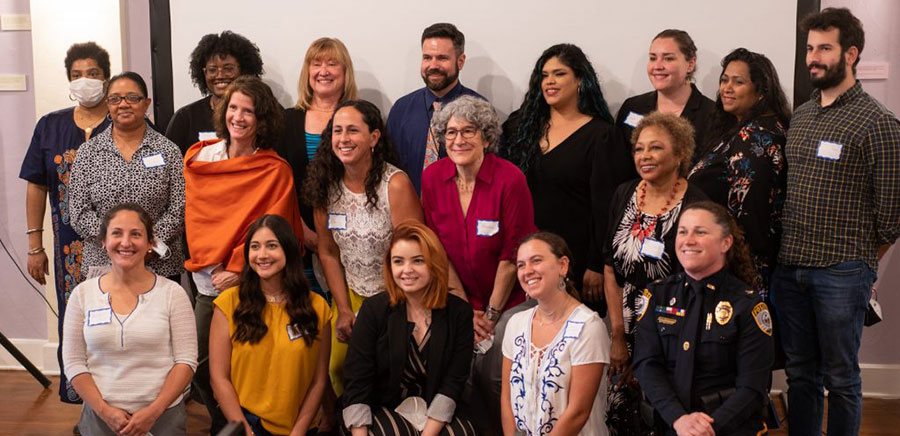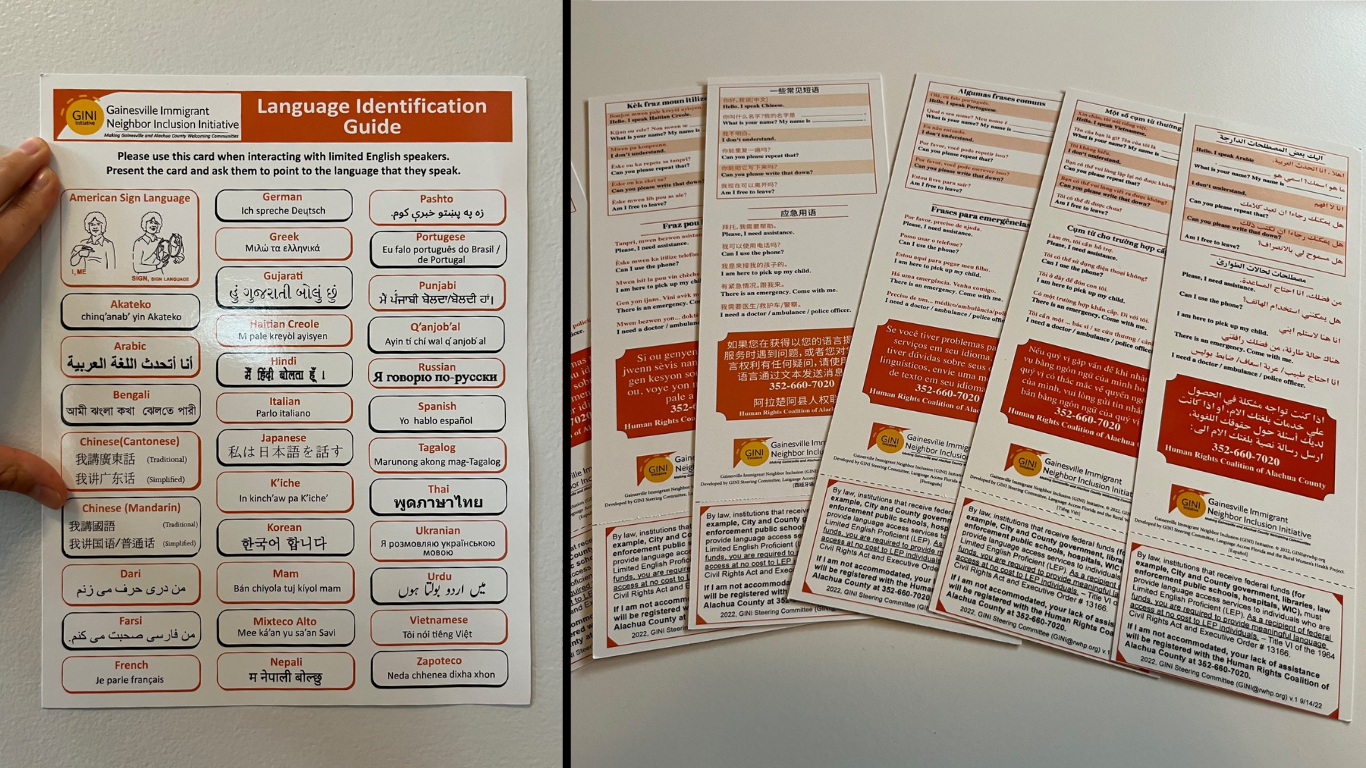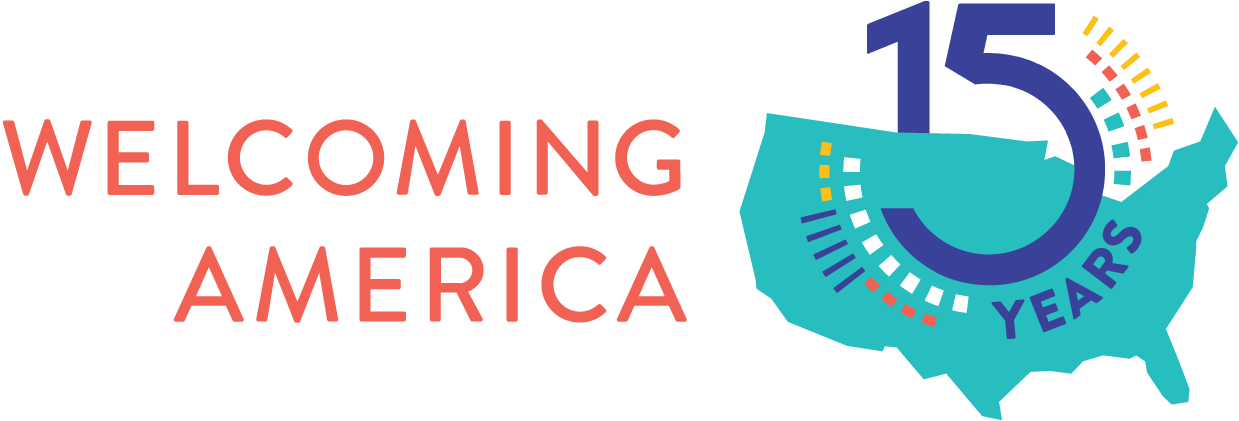
Welcoming takes root in the south: How one Florida community fosters safety and language access
Words and intentions aren’t enough to create a community where everyone belongs. Residents of Gainesville and Alachua County, Florida know how much effort it takes to make their home a more welcoming place to live.
“To be a welcoming community means that you have policies in place which become everyday behaviors and actions, in turn, building respect, safety, and inclusion,” says Robin Lewy, the director of the Rural Women’s Health Project (RWHP) and co-lead of the Gainesville Immigrant Neighbor Inclusion (GINI) Initiative.
“Without policies that have an accountability element, your welcoming is just words,” she says.
As the Gainesville community becomes more diverse, strides toward inclusion and equity are in no small part due to the GINI Initiative’s work to make welcoming immigrants and refugees a priority: not just talking the talk, but walking the walk.
Florida is the third most populous and fastest-growing state in the United States, with one in five residents born in another country. In Gainesville alone, immigrants accounted for 24 percent of the population growth between 2014 and 2019. Despite anti-immigrant policies and attitudes within the state, it’s clear that immigrants are making Florida their home and in turn, enhancing the communities they live in.
“We see that immigration is not going to stop or diminish anytime soon,” says Ethan Maia de Needell, immigrant program manager at RWHP and member of the GINI core team. “Our communities are diverse, and only by opening our arms and embracing it do we stand to reap all the benefits.”
As a community in the south, Gainesville shows us that local change is both possible and necessary, all thanks to the community members pushing for immigrant inclusion. Read on to learn about how the GINI Initiative is advocating for local action to support newcomers or listen in to a key part of their story below.
How welcoming took root in Gainesville
Within the past decade, the City of Gainesville and Alachua County passed welcoming resolutions and joined the Welcoming Network. Although the community was already beginning to recognize the importance of welcoming, in 2018, a tragic incident highlighted the urgent need for immigrant inclusion and justice.
After a domestic violence call to the police led to the victim and witnesses facing deportation, more of the Gainesville community began to see how local policies and practices were harming immigrants.
“Within 24 hours, we had a meeting of 40 different individuals and organizations coming together,” Robin says. “It became a starting point for waking up our city, specifically to their lack of preparation and understanding.”
Importantly, following this incident, the police department was the first public agency to embrace the recommendations that the community laid forth. Transforming challenges into opportunities was a catalyst for Gainesville’s journey to inclusion: issues like language access and community-police relations helped welcoming solutions gain momentum over the next few years.
Eventually, the GINI Initiative took form and the coalition held listening sessions in English and Spanish to understand and identify challenges newcomers faced in Alachua County. Around 60 people shared their ideas and experiences. Soon after, the GINI Steering Committee kicked off their first meeting and began developing the welcoming plan that could officially guide the city and its partners toward true welcoming.
Creating a welcoming plan
Gathering feedback from the community was the first step to creating a welcoming plan. “Aside from constant meetings for close to a year, we created a survey in multiple languages and sent that out to the immigrant community through our partners and our community health workers,” Ethan explains.
Over 180 survey responses were collected. This data, alongside the findings of Gainesville’s Gateways for Growth report, gave the GINI team new insights to inform the recommendations they included in the GINI Blueprint.
The blueprint outlines actions that community stakeholders, like local government and public institutions, should take to advance immigrant inclusion and safety. The recommendations are grouped into five categories — safe communities, engaged communities, healthy communities, equitable education, and equitable access — and are influenced by the seven framework areas of the Welcoming Standard.
“It's been a great guide for us to use,” Ethan says. “Whenever we're feeling a little lost, it's outlined there, action by action.”
Aside from providing tangible steps to make their community more welcoming, the GINI Blueprint was also an opportunity to publicly proclaim welcoming values and get media attention on important issues for immigrant populations and advocates. The GINI team held a launch event in 2022 to share the findings of their research and highlight the key actions in the blueprint.
“Seeing institutions like the city, county, and schools come out in support of it was very important to us,” Ethan says of the blueprint launch. “This has helped us to hold their feet to the fire when they’re not taking those action steps to heart.”
Looking ahead, the team at RWHP is hopeful that the city will take the next step to officially endorse and use the GINI Blueprint as the official roadmap to achieve immigrant inclusion in Gainesville.
Recognizing and supporting language diversity
RWHP and the GINI team have been investing in language access to strengthen communication and meet the needs of immigrant communities. Why? The director of Language Access Florida and GINI member Laura Gonzales, Ph.D., says, “Language access is not just about having access to an interpretation line. Language access is about engaging in open dialogue with our multilingual community members so that they can feel welcomed, included, and recognized.”
Language access is foundational to achieving all of the outcomes within the GINI Blueprint. To have true safety, engagement, and equity, local government and other community-serving organizations need to communicate with residents regardless of the languages they speak.

Language ID guide (left) and "I Speak" cards (right)
To facilitate communication across Gainesville, the GINI Initiative developed two free materials to support access to language services:
- The language identification guide is a tool organizations can use to find the primary language of people who have limited English proficiency so they can access interpretation services. The guides contain the 30 most commonly spoken languages in North Central Florida. So far, they have been distributed to every public school in Gainesville, many health clinics and community health workers, and a local college.
- “I Speak” cards provide the user with critical phrases in English and inform whoever the cardholder is communicating with what their primary language is. Importantly, the card acknowledges their legal right to an interpreter at any organization receiving federal funds. These cards are currently available in six languages.
“Local governments and other institutions that receive federal funding should care about language access because language access is a civil right,” says Laura. “Upholding language access rights is not just a nice thing to do; it's also part of following the law. With this in mind, governments and other organizations should want their membership to reflect the reality of our multilingual world. We should all want to understand and engage with perspectives that come from our multilingual communities.”
The Matheson History Museum in Gainesville has been a key partner in spreading awareness of language diversity in North Central Florida. Executive Director Kaitlyn Hof-Mahoney says, “We have been honored to share the stories of our immigrant neighbors through our recent exhibition, We Are Here: Stories of Multilingual Speakers in North Central Florida. It has been an excellent opportunity to both make new audiences feel included and also educate our existing audience about a topic that they may not have otherwise been thinking about. Moving forward, a greater awareness of these smaller groups of language speakers is a strong step towards greater inclusion and creating welcoming spaces.”
Advocating for language access in schools and beyond
“Many people assume that rural parts of Florida, such as where I live in Gainesville, are not linguistically diverse,” Laura shares. “However, due to always-shifting migration patterns, and in part due to the increased number of multilingual migrant farmworkers, rural parts of Florida are increasingly linguistically diverse.”
In Alachua County Public Schools alone, more than 30 languages are spoken at home by students across the district. Spanish, Portuguese, Chinese, Arabic, Vietnamese, and Korean are the most common. According to the director of ESOL (English for Speakers of Other Languages) programming, the school district has seen a 54% increase in ESOL enrollment, jumping from 845 students in 2019 to 1,298 in 2023.
“I was raised here in Gainesville, and I think the landscape has been changing a lot recently,” says Ethan. “Wherever I go, there’s always someone speaking Spanish, and I don't remember [hearing] that when I was growing up.”
Over the past year and a half since the launch of the blueprint, the GINI Initiative has been meeting with school officials to relay the importance of language access and provide specific steps that the schools can take. To put extra pressure on the school district to create a formal language access plan, the GINI team created a petition demanding that all students and families are served equitably, regardless of the language they speak or their country of origin.
“We got over 600 signatures from our community, many of which were limited English proficient families themselves,” Ethan says. “That was really important when we presented it at a school board meeting, to show that it's not just GINI who are demanding this, it's the community. Since that school board meeting, we've had close to five different stories come out about language access at the schools, so that's helped to bring awareness to the issue.”
“Without policies that have an accountability element, your welcoming is just words." — Robin Lewy
Laura emphasizes, “My hope is that organizations in Gainesville and beyond continue working to recognize the importance of language access beyond a simple checklist. The state of Florida benefits tremendously from multilingual immigrants, and in particular from multilingual immigrants of color. Language access is a civil right that requires our constant attention and engagement.”
Within the Gainesville area, more and more education partners are taking steps to advance language access for students in the community.
For example, Ethan shares, “The ESL program at Santa Fe College has been such an incredible partner throughout this whole process. We are going into classes, passing out materials, focusing a lot on the importance of language access, and specifically going into the rights that we all have in our community.”
Through this work with Santa Fe College, RWHP will reach nearly 200 students who are in the process of learning English. The GINI Initiative hopes to see the University of Florida, which is based in Gainesville, adopt many of the same approaches and tools to ensure language access among its students, staff, and faculty.
The GINI Initiative has benefited from the community’s early efforts to build a more welcoming community so far. The team acknowledges that both local governments have a long way to go to achieve the outcomes of the GINI Blueprint, but are eager for a future where transparency, accountability, and long-term infrastructure make Gainesville a place where everyone belongs and feels welcomed.

